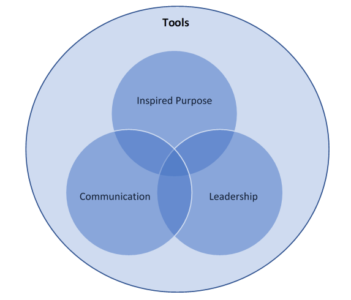We’ve been at agile for a while now, long enough to know that coaching high performance is not so easy.
We’ve accrued a great deal of experience and a number of theories and methods have been offered up. The question is, are there any simplicities in all this that we’ve missed, or relative importances that would help us better order and leverage all this data?
I think so.
Here’s what I have observed:
Purpose is king. Really the broader concept of purpose driven by out of inspiration. Inspired purpose.
Inspiration and purpose create alignment. They are the heart and connecting thread of culture. With gobs of inspired purpose other factors like presence and collaboration, even trust, can surface. Teams are moved to rise above dysfunction and to discipline themselves. Conversely, in the presence of a weak purpose you struggle mightily to establish any of these other necessary behaviors.
Another bedrock is communication. I know; this is a bit like saying your body needs food to keep going. Not all that enlightening. But zeroing in and anchoring on communication is quite helpful. As Westrum pointed out, it’s information flow that signals the culture. Communication – good or bad, present or not – is both the leading indicator and step number one in remedying most of the situations we confront. We can break it down into any number of facets – into presence, listening, empathy – but simply knowing to start by looking at communication has power.
The last one is leadership. Probably cooking is the only subject that has more books written on it, but we want to focus on just a few elements. First is creating safety for the team, simply by standing up for them, having their back. The second is being straight with the team; honesty. These first two require courage. These behaviors are also part of “being the change” in Gandhi’s words, and of leaders going first.
So what’s the point? It’s that these are the first things you need to attend to in establishing a team, and the first things you should look to when examining a team’s functioning.
For example, Mike Cohn suggests getting a team started by having them begin producing together quickly. Then think about other team building. This is actually brilliant. On a very immediate basis you’re establishing communication and some alignment to purpose; something you can then build on.
And in remedying problems, even root causes like missing skills for example are evidenced by the person or group slipping out of communication with their work or their environment. You can easily spot similar examples of fundamental impact of a lack of leadership.
The hypothesis, then, is that when you have these three elements, the rest – things like trust, like positive conflict, empathy, continuous improvement, team self-awareness and management – can follow. Without them, you will struggle to achieve any of them.
Another hypothesis is that they are symbiotic; they reinforce each other.

Communication certainly improves in the presence of strong purpose. But good communication provides a supportive environment for purpose to express itself as well, and for leadership to emerge; leadership that will further nurture the other two. And so on.
These elements and relationships have power because they are simple. This is not to suggest throwing all other team building and coaching tools overboard! Not at all! But these fundamentals can provide quick reference points leading to the precise problem to be addressed and the best technique to apply.
And, admittedly, the more coaching tools we acquire the more susceptible we can sometimes become to missing the obvious. Like when the help desk asks us, “Is the computer plugged in?”
Starting with these three bedrocks can help us to face and address some of the really hard problems, the elephants in the room – the lack of real communication, the lack of courageous leadership, the lack of purpose.
With these three fundamentals solidly in place, you will have a team.
But when it comes to a high performing software development / digital services team, there’s another key element: tools. The team needs DevOps (which is more than tools; effective implementation of the DevOps principles and practices depends on the three elements we’ve discussed, so we focus here on tools as an additional ingredient) . They may hang together and be inspired, but if they’re blocked from fast learning cycles and experimentation, encumbered by the technical environment, they will be constrained from ascending.

So that’s the picture
Get those three fundamentals in, support them with tools, and all the other approaches suddenly can be applied to result.
Some references:
- The core values of both Scrum and XP, both of which include courage
- Gene Kim presentation Meet Gene Kim (preview of The Unicorn Project) DC Scrum Users Group, April 24, 2019
- Conversations, Don MacIntyre, on Sutherland’s emphasis on simplicity
- Patrick Lencioni’s The Five Dysfunctions of a Team
- Mike Cohn’s Succeeding With Agile
- Mark Schwartz’s A Seat at the Table
- Simon Sinek’s Start with Why
- Sinek’s presentation/video Leaders Eat Last – speaking to the need for courage and honesty in leaders
- Westrum’s A Typology of Organisational Cultures

